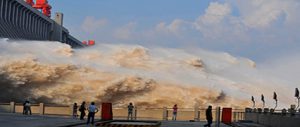California’s governor Jerry Brown is facing mounting obstacles to his 50-year plan for revolutionising water provision in the US’s richest state.
The controversial plans include the construction of two enormous tunnels which will divert water around a sinking river delta located east of San Francisco Bay.
Roughly two-thirds of Californians get a portion of their tap water from the Delta. Twin tunnels, each 37 miles long and gravity-fed, would be capable of moving 9,000 cubic feet of water per second, while eliminating two of the five intake facilities in a previous proposal to which environmentalists objected.
Their purpose is to irrigate farms in California’s Central Valley on a reliable schedule while reducing harm to fisheries in the vulnerable delta ecosystem. Supplying water to the residents of semi-arid Southern California cities is another aspect of the plan, which infuriates many northern Californians who regard this as an old-fashioned water grab.
Unsurprisingly, this US$14 billion water scheme has already stirred up old regional rivalries that have bedeviled the state for 150 years. With climate change looming, there is a lot at stake.
A history of mounting opposition
Native American tribes, environmentalists, anglers and commercial fishermen have spouted off against agri-business interests, local water districts and bureaucrats at rancorous public meetings. Politicians and farmers find themselves on both sides of this water fight, depending on where their fields or constituents are located, and many cynics question whether such a mighty project can prove sustainable, ecologically sound and financially viable.
After all, 30 years ago Californian voters blocked a peripheral tunnel, championed by a young Governor Brown and designed to convey water from the same region, because of its prohibitive cost.
What’s different this time? “Current efforts to establish a reliable water supply for 25 million Californians and farmers who grow an affordable and healthy food supply and at the same time restore the Delta ecosystem is not the same proposal from 1982,” said Mike Wade, who heads the California Farm Water Coalition.
“Since that time, next to nothing has been done to resolve the water supply issue and the Delta’s ecosystem other than redirect water from farms, homes and businesses for environmental purposes that, by all measures, have failed. Years of scientific study and US$150 million provided by public water agencies have brought us to the current proposal by Governor Jerry Brown and US interior secretary Ken Salazar. If California does not move forward and fix its water supply problems with improved conveyance and protections in the Delta, then we will be inviting disaster.”
Others remain cautious. “If ‘getting it done’ means cutting corners, leaving out details and getting ahead of the science, we’re not actually getting anything done – we’re just getting into a trap. Keep in mind what is at stake here,” said George Miller, a congressman from Martinez.
“A badly designed plan can harm drinking water supplies, further endanger California’s salmon runs and ruin the economic livelihood of tens of thousands in the fishing and related industries up and down our coast.”
The Bay Delta Conservation Plan centres on 1,800 square kilometres of backwaters where the San Francisco Bay meets the confluence of California’s principle rivers, the Sacramento and San Joaquin. Currently, intensive pumping of water from the southern end of the Delta sometimes causes flows into San Francisco Bay to reverse, sucking saltwater and invasive species upstream.
Mercury contamination, caused by reckless mining practices from the boom days of the California Gold Rush, also gets spread through tidal surges and pollutes the spawning grounds for delta shrimp and Chinook salmon. Green sturgeon, smelt and steelhead are also at risk.
This delta was painstakingly reclaimed from swampland in the 1850s when Chinese laborers built more than 2,000 kilometres of levees in the tule marshes. Nearly all the original wetlands have vanished, replaced by islands and tracts that form a patchwork of farms and orchards interlaced by aqueducts, channels, oxbows and dams.
A risky political legacy?
Many fertile fields, growing everything from alfalfa to zucchini, now lie 25 feet below sea level due to soil subsidence. Climate change is increasing the severity of storms; snowmelt in the Sierras, which feeds California’s rivers, is less predictable. Relying on these antique levees to protect urban developments in and around the Delta, as well as to prevent incursions of San Francisco Bay’s saltwater, may end in catastrophe.
“This proposal balances the concerns of those who live and work in the Delta, those who rely on it for water and those who appreciate its beauty, fish, waterfowl and wildlife,” Governor Brown told reporters when he unveiled the twin tunnel scheme.
Barbara Barrigan-Parrilla, executive director of Restore the Delta, is not convinced. “Powerful forces are using fear of flooding and earthquakes to make a case for transforming a unique, beautiful, productive region into a permanent way station for water going somewhere else,” she pointed out. “They are trying to shore up an outdated water system with a massive, multi-billion dollar water transfer project that Californians will be paying for decades.”
Brown’s critics worry that the governor’s goal is to insure his political legacy with a big public works endeavor, risking California’s environment with a pricey water project aimed primarily at farmers growing surplus crops for export. Conservationists despair that greening the desert with dollars is apt to wreak havoc on the habitat. They often bring up a line from Cadillac Desert Marc Resiner’s seminal book on the watering of the American West: “In the Western United States, water flows uphill to money."
Caleen Sisk, chief of the Winnemem Wintu tribe, put it simply: “Let’s stop big agri-business from polluting and taking water." Demands for better flood control, water recycling, access to extra water for use in droughts and new funds for the restoration of floodplain and tidal marsh habitat are under consideration.
Jay Lund, professor of environmental engineering at the University of California Davis’s Center for Watershed Sciences, is a leading expert on the Delta.
“Special interest groups use the public meetings as a chance to ramp up the rhetoric. What we need is a more civil and productive discussion,” he told chinadialogue.
“The BDCP is not too specific-and that’s a good thing. We will need adaptive management because large parts of the Delta are likely to change, due to flooding, subsiding islands, sea-level rise, lots of major factors. It’s fragile. It will take some time – several years of intensive planning. Construction might not begin for five years.”
China and California: comparisons
Comparisons to the challenges of China’s South North Water Transfer Project are complicated because California’s surface water has not yet been rendered useless by severe industrial pollution. What’s more, the 44.8 billion cubic metres of water per year that China plans to divert from the Yangtze River to the Yellow River Basin in the north is immense – nearly half the annual water consumption by all Californians. That’s a lot of water.
“The big difference between us and China is that the California water system is so decentralised,” Lund observed. “That provides the ability for incremental change. In California, we have some very smart people with authority for action and accountability, even enabling them to work deals with other agencies. But there can be difficulty for major strategic changes. There are so many legitimate concerns, it can bog down the system. Big things are controversial. They require big decisions. Most of California’s infrastructure was built during an era where we had more centralised government.
"If the Bay Delta Conservation Plan is put in place, it won’t be a panacea. It will be expensive, and negative outcomes will be blamed on tunnels.”
Governor Brown is determined to get a consensus and start digging. “We’re going to take into account the opposition, but we’re not going to sit here and twiddle our thumbs… we’re going to make decisions and get it done. If we have to fight initiatives or referendums, we’ll fight those too,” Brown said. “I expect to get some very important things done, and this is one of them.”
Homepage image by U.S. Geological Survey



